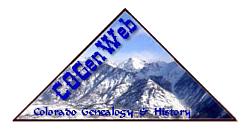
.png)

 |
.png) |
 |
| Home |
Archives |
Biographies | Books |
Cemeteries | Census |
Churches | Cities |
History
| Libraries | Maps |
Miscellaneous |
Vital Records State Coordinator - Colleen Pustola | Asst State Coordinator - Betty Baker | Asst State Coordinator - Rebecca Maloney | Asst State Coordinator - M.D. Monk | County Coordinator - Available! |
| Websites can disappear and addresses can change. Please advise if you find a broken link on the Denver County, COGenWeb pages. Let me know at my above email address. The city of Denver was, in the earliest years, located in Arapahoe County. By 1901 the people of the "Mile High City" believed that Denver should govern herself and they left Arapahoe County to form the "City and County of Denver." In 1902 the state recognized Denver as a separate county. In the one hundred three years since, Denver has spilled over into the surrounding counties and has fulfilled the dreams of her founders beyond their wildest expectations. For a history and/or timeline of Denver see Denver History.  This is the Former Kansas Territorial Governor, James W. Denver, for whom this city/county was named. Denver was created from a portion of the original Arapahoe County, which was previously carved from the Kansas Territory. The Territory of Kansas was an organized incorporated
territory of the United States that existed from May 30, 1854, until
January 29, 1861, when the eastern portion of the territory was admitted
to the Union as the free state of Kansas.
The territory extended from the Missouri border west to the summit of the Rocky Mountains and from the 37th parallel north to the 40th parallel north. Originally part of Missouri Territory, it was unorganized from 1821 to 1854. Much of the eastern region of what is now the State of Colorado was part of Kansas Territory. The Territory of Colorado was created to govern this western region of the former Kansas Territory on February 28, 1861. The question of whether Kansas was to be a free or a slave state was, according to the Compromise of 1850 and the Kansas–Nebraska Act, to be decided by popular sovereignty, that is, by vote of the Kansans. The question of who were the Kansans who were eligible to vote ended up causing armed conflict, called the Bleeding Kansas period. Both pro-slavery and free-state partisans encouraged and sometimes supported financially emigration to Kansas, so as to influence the vote. During part of the territorial period there were two territorial legislatures, with two constitutions, meeting in two cities (one capital was burned by partisans of the other capital). Two applications for statehood, one free and one slave, were sent to the U.S. Congress. The departure of Southern legislators in January 1861 facilitated Kansas' entry as a free state, later the same month. In the summer of 1858, during the Pike's Peak Gold Rush, a group of gold prospectors from Lawrence, Kansas, established Montana City as a mining town on the banks of the South Platte River in what was then western Kansas Territory. This was the first historical settlement in what was later to become the city of Denver. The site faded quickly, however, and by the summer of 1859 it was abandoned in favor of Auraria (named after the gold-mining town of Auraria, Georgia) and St. Charles City. On November 22, 1858, [it is alleged that] General William
Larimer [seen here below] and Captain Jonathan Cox, Esquire,
both land speculators from eastern Kansas Larimer, along with associates in the St. Charles City Land Company,
sold parcels in the town to merchants and miners, with the intention of
creating a major city that would cater to new immigrants. Denver City
was a frontier town, with an economy based on servicing local miners
with gambling, saloons, livestock and goods trading. In the early years,
land parcels were often traded for grubstakes or gambled away by miners
in Auraria. In May 1859, Denver City residents donated 53 lots to the
Leavenworth & Pike's Peak Express in order to secure the region's first
overland wagon route. Offering daily service for "passengers, mail,
freight, and gold", the Express reached Denver on a trail that trimmed --for additional history and information, see Wikipedia.
|